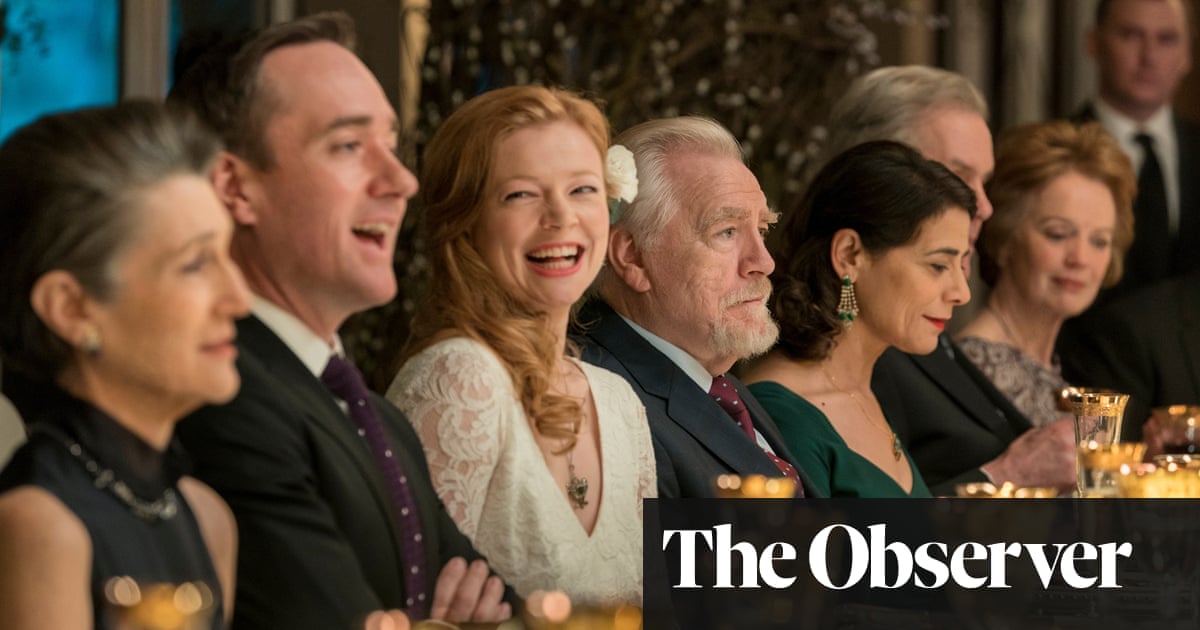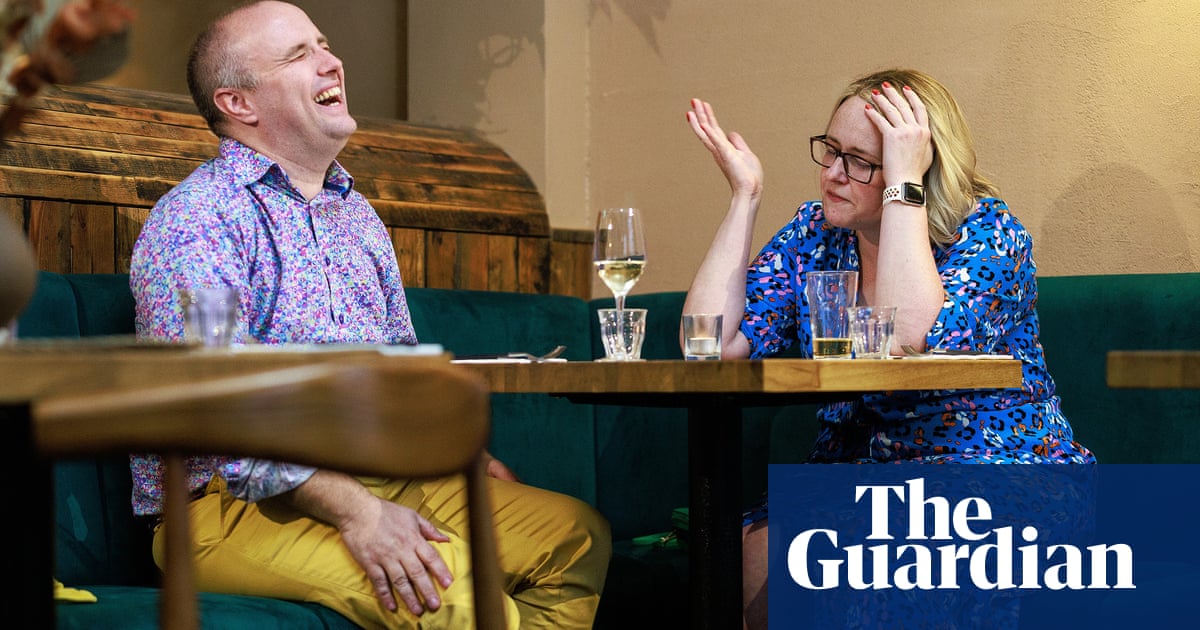
On 15 September 2016, Rob Pope, a chipper veterinarian from Liverpool, sat down in the chair of Fluke’s Barbers in Mobile, Alabama, and readied himself for a haircut. “So what would you like?” the barber asked him. Pope held up a photo of Forrest Gump. It had taken years of planning for Pope to embark on this trip to America, to make it to this barber’s chair. He’d spent countless hours daydreaming about it, building the momentum to go. As his job became ever more miserable – he was working 13-hour days, five days a week – the urge to escape became insurmountable. He quit and, along with his partner and fellow vet, Nadine, headed west.
In many ways, the seed for this adventure was sown in 2002. That was the year Pope’s mum, Cathy, died after a cancer diagnosis. Cathy was a medical laboratory scientific officer and a single parent. She raised Pope with grit, determination and heartfelt support of his passion: running. He’d shown promise at the sport since his school days when he took part in the oft-dreaded cross-country and excelled at it. Cathy would take him to his races, which soon became marathons. Marathons after marathons. To Pope she was a best friend, a rock, an inspiration, a support-crew leader. Before she died she asked him to make a promise: “Do one thing in your life that makes a difference.” These words echoed in his mind as he sat in that Alabamabarbershop, awaiting his turn beneath the clippers.
A brisk buzz later, Pope stepped out on to the street. His hair was groomed into a “high and tight”, as the barber described it, and he was decked head to toe in Gump attire: chinos, checked shirt and a brand new pair of white Nike Cortez sneakers. He donned his red Bubba Gump Shrimp Co cap and, well, started to run. Just like Forrest Gump, he didn’t stop until he’d run across America almost five times.
Even if you’ve never seen the film or read the book you’ve probably heard of Forrest Gump. Gump is one of those archetypal screen characters who captured the public imagination. Like Rocky or Mia Wallace or BA Baracus, he mostly exists as a jumble of catchphrases and easy-to-assembl fancy-dress party accessories: “My mama always said, life was like a box of chocolates, you never know what you’re going to get.” That’s classic Gump. “What’s normal anyways?” That’s another. Then we have the most iconic quote from the film, though it was not actually uttered by Gump himself: “Run, Forrest, run!”
The character originated in a novel by Winston Groom, published in 1986. It tells the story of a man born in Mobile, Alabama with a low IQ who innocently drifts through several decades of social churn. Gump pops up in the Vietnam war and plays ping-pong in China. Oh, and there’s Jenny, his first-grade crush and lifelong love. Naturally, the book did poorly. The 1994 film, however, starring Tom Hanks, was a hit and won six Oscars, including best picture, best director and best actor.
The film’s pièce de résistance – an iconic sequence in contemporary Gump-lore and the moment that created a spark of inspiration in Pope’s mind – was a scene that didn’t occur in the book. It almost didn’t appear in the film either. The sequence only exists because Hanks and director Robert Zemeckis agreed with Paramount that they would personally foot the bill for shooting it. It is, of course, Gump’s iconic cross-country run. Seven minutes of heartwarming cinema in which the lovable hero traverses beautifully shot all-American scenery.
The starting line is Gump’s whitewashed wood Alabama home. He’s sitting on the bench outside it, sullen-faced, staring into space. He’s got a good reason to be sad – Jenny has effectively just ghosted him – but soon enough, he rises and, “for no particular reason” decides to “go for a little run”. He runs to the end of the road, the end of town, across Alabama and keeps going until he hits the ocean. Once there he figures: “Since I gone this far, might as well turn around, just keep on going.” He reaches another ocean, then turns and runs back again. This guy sure likes running. America is watching now. News teams pursue him. Gump gains a band of disciples who run behind him. He grows a massive beard (Gump fancy-dress costume number two). Gump runs for three years, two months, 14 days and 16 hours. He crosses the United States almost five times before deciding that it’s finally time to go home again. Most of us watched that scene and thought: cute. Pope watched it and thought: could that be possible?
The first recorded crossing of America on foot was in 1896. The circumstances were fairly desperate. In the hope she could save the family farm, Helga Estby, a Norwegian immigrant and suffragist living in Spokane, Washington, took on a wager for $10,000 that she could make it to New York City in seven months without transport. She and her daughter, Clara, walked 25-30 miles a day and wore out 32 pairs of shoes before they reached the East Coast, only to find their sponsor refused to pay up. They returned by train.
In 1909, Edward Payson Weston, aged 70, made the first coast-to-coast crossing when he walked the distance in 100 days. He became a national celebrity, but it was not until the second half of the 20th century that the idea really began to roll. Writing in Outside magazine, Martin Huber pinpoints the 1970s running boom as the moment America-crossing entered a new competitive era. (Gump completed his fictional run this very decade.) People were now making the journey in under 60 days, running 50 miles each day. In 1980, Frank Giannino Jr, a shoe salesman, made a record crossing of 46 days, eight hours and 36 minutes. That’s 72 miles a day. It wasn’t broken until 2016, when Pete Kostelnick, the current record holder, completed the run in an astounding 42 days, six hours and 30 minutes.
Pope was inspired by these America-crossers – there’s an entire community of them who often cross paths as they traverse desert highways – and he devoured a book by a British runner, Nick Baldock, who ran from San Francisco to New York in 1999. As he now writes in a book of his own, Becoming Forrest, Pope was “captivated” by Baldock’s account of the journey, which documented the “epic scale and beauty” of experiencing America in this manner.
Speaking on Zoom from his home in Liverpool, still sporting a full beard with a red cap on his head, he tells me how he emailed Baldock for advice. Baldock spurred him on. “I started researching routes across the country,” says Pope. “And, of course, stuff comes up about Forrest.”
As Pope explains in his book, the character has long been assimilated into the world of running. “If you’re a runner who’s had the pleasure of passing a gang of youths or a bar, especially if you have long hair and, God forbid, a beard, I’d be willing to bet you’ve heard the shouts of ‘Run, Forrest, run!’” writes Pope. “Anyone who undertakes a challenge more than a few marathons long seems to be labelled as the ‘[insert adjective or nationality here] Forrest Gump’.”
Pope was not the only person to have wondered about this fictional run. Online he found various suggestions of the route. One person had pinpointed all the major landmarks from the film and calculated it at 15,248 miles. “Which is, of course, ridiculous,” says Pope. “No one has run that far.” The commonly held view was that it was impossible. But if Pope was to do something ambitious, to make this run the “one thing” he promised his mum that he’d do, he had to go big. It was for charity. It needed mass appeal. One crossing, impressive though it is, wouldn’t cut it. It needed to be five.
The idea of the run was more important than the speed it was completed in, but Pope was still a fast runner. At the 2015 Australian Athletics Championships he was crowned the national marathon champion with a time of 2:29:59. He’d beaten that on other occasions, too, but challenges like this were a different beast. Pope explains that the best thing about ultramarathons (defined as any run longer than the marathon distance) is that you don’t need to rush: “You can eat. You can stop. No one asks you what your ultra personal best is – they just ask how far it was and then go, ‘Wow!’” Yet at the time Pope could hardly describe himself as an experienced ultramarathon runner. This would be a step into the unknown. “I thought, well, let’s just give it a go as a scientist,” says Pope. “This can be my next experiment where N equals 1 and that N was me.”
Starting from Mobile, Alabama, Pope, then aged 38, began his great experiment. The next 18 months would be consumed by running, punctuated only by brief hops back to the UK to refresh his visa. For around half of his time on the road, shelter (and emotional support) was provided thanks to Nadine, who accompanied Pope in an RV. This was a DIY operation. Pope had no major sponsors and the budget was tight. “You see people doing these runs with a driver, physio, nutritionist, everything,” says Pope. “Nadine was all of those things… psychotherapist, too.” Apparently she didn’t need any persuading to join Pope. “She’s just nice like that,” he says (he does seem sincerely grateful).
In between the adventure – starry skies, Highway 61, roadside Americana, a moose, a bear – was the 40-mile-a-day grind. Each morning Pope would wake up, eat maple sugar oatmeal mixed with a protein shake. Start running. Second breakfast: doughnuts. Perhaps a Dr Pepper (Gump’s favourite drink). Some more running. Lunch, every day, says Pope, was ham salad and catalina dressing sandwiches. “I’d never had it before America, and I’ve never had it since, but I never got bored of it.” Time for a mid-afternoon snack: doughnuts. Then a huge dinner of mashed potatoes and a microwave burrito. That was his diet when Nadine was there. On the sections that Pope ran on his own, he went full teenager–away-from-home: McDonald’s, Burger King and Subway punctuated by Twix bars. “I was probably putting away 5,000 or 6,000 calories a day,” he said. “When I’d fly back to renew my visa I’d put on a stone and a half in a couple of weeks.”
Pope dodged traffic, counted roadkill and experienced the whoosh of 18-wheelers overtaking on the highway.
This Gump-like figure caught people’s eye, too. Over the course of his run the phrase “Run, Forrest, Run” was yelled at him at least 500 times. One man shouted it him, then turned around, drove back and apologised. “I was like, ‘Nah, you got that right,’” says Pope. Once, when Pope needed to take a toilet break, he knocked at a house in the middle of a cotton field in Texas. The man who lived there invited him to sit down. “So, I watched this film last night called Forrest Gump,” the man said. “Do you know it?”
“Yeah,” said Pope. “Fairly well.”
The man continued: “Because when you knocked on my door, I was just like, ‘This guy really reminds me of Forrest Gump.’” At this point, Pope explained himself. The man was speechless. He said: “I’m not going to tell my family about this because they’ve been looking to put me into care for years. If I tell them Forrest Gump came over and took a dump in my toilet, I’ll be off to the infirmary.”
When Pope was running solo he carried his kit in a pram of the sort you might see being pushed by a sprightly parent doing laps of your local park. Sorry to break it to you, dads, but Pope ran 8,000 miles with one of those. Sometimes it attracted the wrong sort of attention. On one occasion, the police stopped him as they’d had reports of a “lady pushing a stroller down the highway”. “I had a big old beard on me at this point,” says Pope, “I said to the cop, ‘Why’s it always got to be a lady?’ The cop replied: ‘You ain’t going to see no man pushin’ a stroller through the streets of Alabama.’”
Like Gump, Pope also experienced what it was like to drift through America when history rears its ugly head. He began his run as the bitterly fought 2016 presidential election campaign whirred into motion. He completed the first leg just as Trump was announced the winner. During his time on the road, Pope found himself speaking with people on both sides – often friends. In a desert truck stop in California, Pope was asked by a group what he thought about Trump. “He’s an interesting guy,” Pope said, diplomatically. “He’s the man!” one of the group replied. “He’s an idiot,” said another. Pope felt that America was slipping into the abyss, but found hope in these interactions; moments in which people were still debating between themselves. Like many travellers do, he also found hope in the kindness of those he befriended along the way. Were these the thoughts he churned over as he ran? “Well, yeah,” he says, “That, and, ‘Why does my leg hurt so much?’ And, ‘Where can I get some more gas-station nutrition?’”
As Pope approached the end of his third crossing of America he was given something even more substantial than food, or politics, to think about. Nadine was pregnant. She weathered the morning sickness out on the road, but when the time came for Pope to turn around – again – and run the fourth leg, she returned home. His mindset began to shift. The bulletproof feeling that had carried him through life evaporated. “I got a sudden sense of my own mortality,” he says. “I became fearful of running at night. I heard about a transcontinental runner who had been nearly killed in a hit-and-run in Ohio. I used to think, that won’t be me. Now I thought: ‘What if it is?’”
Something bigger than Pope’s desire to run was brewing back in Liverpool. As Nadine’s pregnancy progressed, Pope was pacing through barren country – Wyoming, Nebraska, Kansas. Cornfield after cornfield, alone with his thoughts. The finish line was on the horizon, but Nadine would be too heavily pregnant to be there for it. Financially, he was skint. He was physically broken, too. “But it was only when I got back to Alabama that I sat down and realised the problem wasn’t physical,” says Pope. “I just wanted to live a normal life.” It was time for a rethink. He was into the fifth leg, but the final stretch would have to wait a little longer. In April 2018, as Nadine’s due date beckoned, Pope headed home for a family interlude.
True to character (his own, not Gump’s) Pope managed to schedule multiple marathons around the birth of baby Bee. He arrived in the UK six days before she was born. Then he ran the Manchester, Brighton and London marathons on three consecutive weekends. All were completed in less than three hours and at London he broke the record for the fastest time run by someone dressed as a film character (guess which one). Legs still recovering, he gathered his family and hopped on a flight to Las Vegas. “What’s the purpose of your visit?” the passport officer asked him at the airport. “Running across America,” said Pope. “Finishing.”
Days later, on 29 April 2018, he did. In Monument Valley, Arizona, Pope ran to that point in the desert road, where Gump finally decided: “I’m pretty tired, think I’ll go home now.” In Pope’s case, not before he proposed to Nadine. In the end, he had run 15,621 miles. He ran for 422 days and got through 33 pairs of shoes.
Today, Pope still talks about the moment like someone flush from a runner’s high. Really it was fatherhood that kept him from experiencing a comedown in the years after his quest. As he says, he was now on an adventure “even more massive” than the previous one. He still runs a lot – when we speak he’s about to tackle 24 Parkruns in 24 hours – and his embodiment of this much-loved character has earned him celebrity status. He brightens people’s day. Pope is serious about running, but, just like Gump, he doesn’t overthink it. Why should someone run? “Because you want to,” he says.












